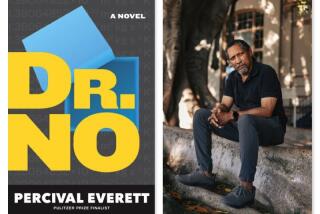A city that tends to dream big
The SAME year Hollywood wrapped a big happily-ever-after bow around “Sex and the City,” the TV and motion picture juggernaut inspired by Candace Bushnell’s 1997 collection of essays, Bushnell herself has come out with a book that shows she’s got her finger on the pulse of reality.
This is not to say that her new novel, “One Fifth Avenue,” isn’t escapist literature. It is. Yet here, Bushnell not only focuses on the usual haves and wannabes and the glamorous world they inhabit, but also on the simmering panic that lurks beneath their sense of entitlement.
Most of the action is set in the posh building that is One Fifth Avenue, long a kind of unofficial club for successful artists of every stripe. Bushnell drops an interloper into this creative mix, a super-rich banker with enough hubris to try to take over the stock exchange of a foreign country -- and succeed.
To nobody’s surprise, the artists and the banker prove to be an oil and water combination. More unexpected is that the building itself is the real star of the book.
If “Big” is the ultimate catch in “Sex and the City,” Bushnell’s latest effort replaces alpha males with real estate as the main object of desire.
One Fifth Avenue seduces all who enter, especially the crown jewel in the building -- the spectacular penthouse. When its owner (one of the city’s oldest and wealthiest philanthropists) suddenly dies, the empty dream palace she leaves behind impacts directly or indirectly every character in the book.
Bushnell assembles an array of New York types, and one, Billy, serves as the connecting link. With the money and pedigree to get invited to the right parties but not enough of either to feel secure, Billy is the ultimate insider-outsider.
Though not a resident of One Fifth -- he “aches” to be -- he understands every shift in the social order, especially when a new face appears on the scene.
In this book, there are two noteworthy newcomers. The more formidable is Annalisa, smart, married, in her 30s, reminiscent of an updated Babe Paley.
The other is Lola, 22, a pampered, pretty girl who believes her generation is entitled to have their dreams fulfilled right now. As she puts it, “Girls my age won’t put up with unhappiness.”
A narcissist and an opportunist, Lola believes that in this age of the Internet, reality TV and overnight fame, she’s just a lucky break away from satisfaction.
What’s compelling about “One Fifth Avenue” is that Bushnell offers plenty of what we want in a breezy read but also goes deeper, exploring what happens when the desire for the best in life doesn’t add up but you can’t stop pursuing it anyway.
And yet Bushnell understands her genre, softening the hard edges of her story so that contemplation never tilts into despair.
With the exception of one character who is set up to be the personification of evil and another who’s more a victim of his own delusions than any malice, “One Fifth Avenue” stays securely inside a world where even when things go rotten, the bottom line is not so bad.
It’s only in a subplot involving a sexy middle-aged actress and her aging bad boy of a former boyfriend that Bushnell gives us two people who are looking for more than a pricey roof over their heads.
This isn’t meant to be noble. Since this duo can already afford a cushy life, they get no points for wanting more. Still, they do acknowledge the need for some kind of meaningful connection in a world driven crazy by status.
If “One Fifth Avenue” ever gets made into a movie, you can bet Hollywood will pump up this romantic angle. But don’t blame Bushnell; she tried to keep it real.
Not that there’s anything wrong with a happily-ever-after ending, but some of us prefer our escapism with at least a few kernels of truth.
--
Carol Wolper is the author of the novels “The Cigarette Girl,” “Secret Celebrity” and “Mr. Famous.”
More to Read
Sign up for our Book Club newsletter
Get the latest news, events and more from the Los Angeles Times Book Club, and help us get L.A. reading and talking.
You may occasionally receive promotional content from the Los Angeles Times.






